List Of Emotions And Feelings
An important part of the human experience are the thoughts, feelings, and behaviors that comprise a shared set of common feelings, or what we call our list of emotions.
Let’s take a look at these emotions that co-exist with and shape other psychological states like personality, mood, temperament, and disposition. You’ll see that emotions can also play a large role in a person’s creativity and motivation.
A list of emotions: Exploring our emotional landscape
Before we dive in to the list of emotions we all share, let’s define what emotions are and from where they originate.
What are emotions?
Emotions. They guide us in big life decisions and small everyday choices. They have an impact on our mood, our relationships, our work, and personal life. At the same time, emotions are reactive biological states and patterns triggered by thoughts, experiences, behaviors, and physiological elements.
Because emotions are subjective, they are highly complex and sometimes difficult to understand, even as we experience them. Most people will likely undergo fear in the face of immediate danger or sadness when dealing with loss. However, emotional responses can vary significantly from person to person.
For instance, we all experience happiness, but the emotion can be triggered by extremely different thoughts or experiences. Furthermore, depending on our circumstances, the same thoughts may or may not make us feel happy.
To further complicate matters, the way we deal with our emotions influences our quality of life. Our ability to manage and express feelings in a healthy way defines our emotional well-being.
The good news is we can learn how to increase our emotional well-being. By becoming more aware of our emotions and the thoughts, experiences, and behaviors that trigger them, we can achieve better emotional health.
The science behind emotions
Emotions have been studied by researchers for several decades now. The first scientist to approach emotions from a scientific point of view was Charles Darwin in 1872. In his book The Expression of the Emotions in Man and Animals, he expressed the opinion, unpopular at the time, that emotions are evolutionary and some of them are universal. Furthermore, he believed some feelings were common in both humans and some animals.
Darwin’s theory was the basis for Paul Ekman’s studies. An American psychologist and pioneer in the study of emotions, Ekman researched their link to facial expressions. His studies led him to the theory that six basic emotions correspond to universal facial expressions: anger, disgust, fear, happiness, sadness, surprise. Later on, he added a seventh emotion, contempt.
Expanding the list
Ekman expanded this list of basic emotions in the 1990s to include a broader range of basic emotions not related to universal facial expressions. Later on, in 1996, researchers Richard and Bernice Lazarus came up with a list of 15 emotions, explained in their book Passion and Reason.
Studies on the topic of emotions are still ongoing, with different approaches and proposals. A famous example is Robert Plutchik’s wheel of emotions, consisting of primary, secondary, and tertiary emotions.
In the 2015 book aptly named The Book of Human Emotions, researcher Tiffany Watt Smith gathered as many as 154 words to express emotions. Some of these are unique to certain countries or cultures.
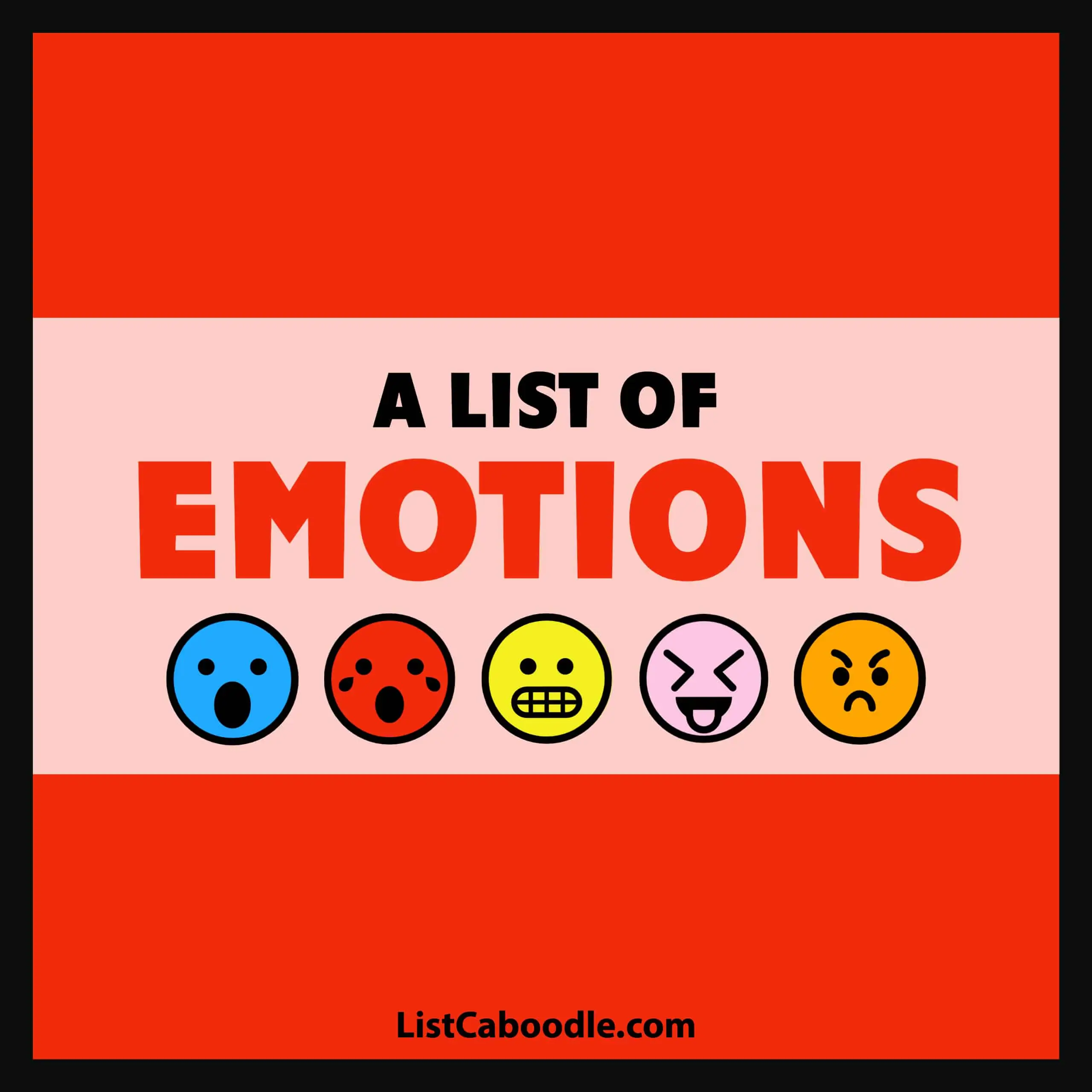
A list of emotions: positive and negative
Try thinking about the emotions you feel in your daily life. Make a mental list of all the emotions you can think of. Almost without exception, you will think about more negative emotions than positive ones. It’s almost as if we were wired to always see the glass half empty.
However, it’s not all your fault. The negative appears to be more pervasive than the positive. Take the list of the seven core emotions defined by Ekman. Five out of seven emotions are negative. There is anger, disgust, fear, sadness, contempt. The two positive ones are happiness and surprise. And to be fair, a surprise isn’t even always positive.
The Dalai Lama
This list also served as an inspiration for the Dalai Lama to create a website, together with Ekman, that would help people navigate their emotions: The Atlas of Emotions. Only five emotions made it to the website: anger, disgust, fear, sadness, and enjoyment.
You may have noticed that these are the same emotions that appear in the movie Inside Out. That’s not a coincidence; Paul Ekman collaborated as an advisor for the movie.
Negative emotions
Apparently, people need more help navigating negative emotions. After all, these are the ones that can cause more damage when we can’t keep them under control. There’s only so much damage an overly happy person can make. On the other hand, turn on the TV on the news channel to see how much destruction a negative emotion can cause.
Nevertheless, things are never black and white. Emotions are more complicated than that, and even seemingly negative ones are useful. At the same time, positive emotions have their dark side too. So before labeling fear as unfavorable and love as positive, it’s worth digging deeper into the purpose and the many angles of each emotion.
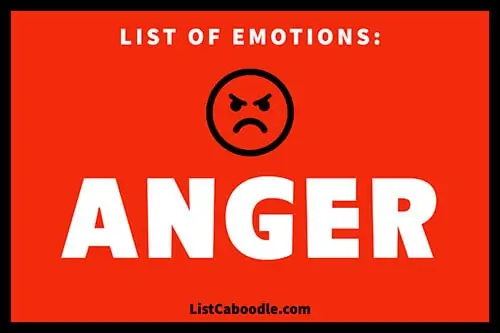
1.) Anger
An emotion that we all experience, in various degrees of intensity, is anger. Despite what you may think, anger is not necessarily a negative emotion. Anger can act as a motivator to solve a problem or take action to make a change for the better. Nevertheless, anger can often lead to negative behavior. Furthermore, feeling angry triggers unpleasant changes in our bodies. Blood pressure rises, and the heart rate increases. This can cause us to react in unproductive ways.
When we feel angry, we usually have three options: expressing our anger, suppressing it, or calming down. More often than not, the expression of anger comes under different forms of aggression, verbal or physical. However, we can also express anger more constructively, especially when directed at another person. We can express our feelings, in this case, anger, by being assertive rather than aggressive. This allows us to convey our point of view without harming others in the process.
Suppressing anger, on the other hand, can sometimes be counterproductive. We keep this powerful feeling inside without giving it an outlet or turning it into something positive. In the absence of an outlet, we direct this suppressed feeling towards ourselves.
Finally, calming down means taking specific steps to reduce the intensity of the feeling and its physical symptoms. To calm down, we may take deep breaths or focus on more positive thoughts. These steps will help manage not our behavior, like in the case of anger expression, but the feeling itself. Choosing to calm down will allow us to practice managing disruptive emotions, avoiding negative behavior altogether.
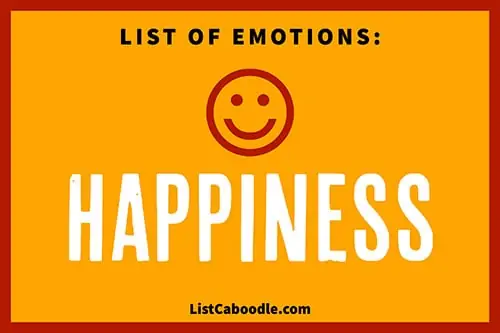
2.) Happiness
Happiness is quite a broad term to define a positive feeling of overall well-being. As opposed to many other emotions, happiness is extremely subjective and can mean very different things for different people. We usually associate it with feelings of joy or fulfillment. Some of us see it more like a state of mind, while others view it as brief and fleeting. We often think happiness can only be triggered by specific occurrences, circumstances, or thoughts.
One thing is true, as humans, we are always searching for happiness, nowadays more than ever. And each one of us seems to have our own recipe for being happy. But if happiness is so subjective, there is no one correct answer to the question “how to be happy?”
From a scientific standpoint, happiness is a mix of life satisfaction, a good balance of positive and negative emotions, and pursuing what makes us flourish. Happiness leads to higher resilience, better financial success, improved mental and physical health, and longer lives.
These are all very good reasons to lead happier lives, in whatever way works for us. What matters, to quote writer Kurt Vonnegut, is to “notice when you are happy, and exclaim or murmur or think at some point, ‘If this isn’t nice, I don’t know what is.”
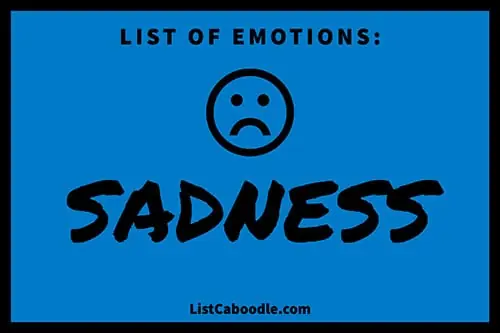
3.) Sadness
One of the six basic emotions identified by Paul Ekman, sadness is a natural and familiar feeling. Like many other emotions, sadness becomes damaging when it increases in intensity and lasts longer.
Severe sadness can lead to depression, a pervasive and extended low mood. Sadness can also trigger and at the same time be started by rumination. The term refers to the habit of constantly thinking about the same things or situations. Rumination can increase sadness and have a significant negative impact on our mental health.
So how do we deal with sadness? And how can we make sure that those common and normal moments of sadness don’t last too long? Exactly how do we prevent sadness from having such negative consequences on our mental health?
Allowing ourselves to feel sadness temporarily is a healthy thing. We should express it in our way, by crying, for instance. But once we have fully experienced the emotion, we should find ways to replace it with more positive things.
We can spend time with loved ones, going outside, exercising, dedicating time to hobbies, or even working. The silver lining of feeling sad from time to time is that it can help us appreciate happiness even more.
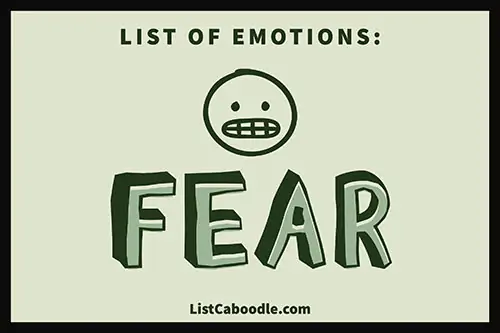
4.) Fear
Fear is a primordial, powerful emotion. It is also a useful emotion, and it has helped our ancestors perceive danger and prepare for fight or flight. Since primitive times, our bodies have adapted to respond to fear in specific ways. Adrenaline levels rise and heart rate increases, pumping blood into our extremities, getting them ready to either run or stay and fight.
But while our ancestors were dealing with real-life threats, like dangerous animals, nowadays we deal with a range of psychological threats. Yet, the response in our bodies remains the same.
Fear is still a valid emotion, and we should pay attention to it. It has the purpose of protecting us from getting hurt, physically or psychologically. However, excessive fear can be counterproductive. When the feeling becomes so strong and persistent, it becomes a phobia. This irrational, excessive fear can lead to significant distress or panic attacks.
Managing our fear is crucial for our well-being. In a situation when we experience fear, recognizing it and accepting it is the first step. To keep anxiety under control, practices like deep breathing or mindfulness have proven very useful.
A list of emotions we all share
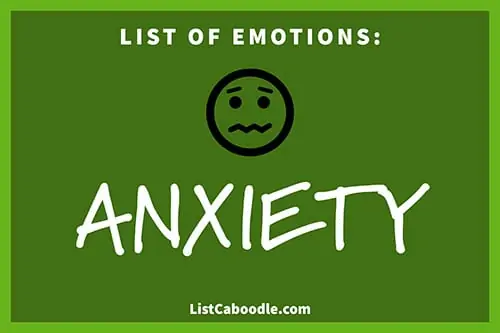
5.) Anxiety
An emotion quite similar to fear is anxiety. The main difference is that fear is usually related to a known threat, while anxiety is a generalized and diffuse emotion. These feelings of internal turmoil, tension, and restlessness are becoming more and more common nowadays.
Especially among young adults, anxiety has seen a significant rise in the last decade. The causes appear to be manyfold, with loneliness and social media exposure being among the main ones.
A certain degree of anxiety is normal before making important decisions or before an exam or a job interview. Feeling anxious can simply mean we are dealing with an important task, determination, or situation. In these cases, this emotion can even be beneficial and lead us to perform better. However, generalized anxiety disorder (GAD) can represent a major obstacle in our lives.
GAD can lead to several mental health issues, and it can affect our psychological, social, and even academic development. Constantly feeling anxious has an impact even on our physical health. Generalized anxiety can cause muscle tension, sleep problems, fatigue, or mental fog.
Keeping anxiety in check can significantly improve our well-being. Like with many negative emotions, certain habits and practices can be of help. We can practice mindfulness and breathing exercises, work out, make sure we get enough rest, and follow a healthy diet.
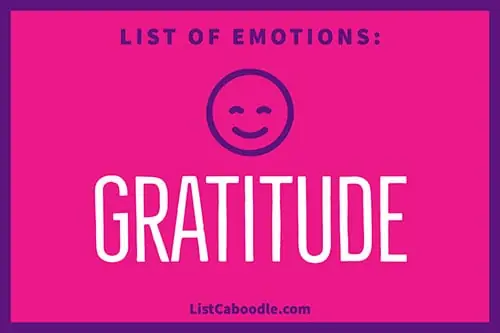
6.) Gratitude
While anxiety is on the rise, so is the practice of gratitude. Science has been focusing a lot on this emotion in the past years. The practice of gratitude is often referred to as a way of increasing happiness and overall well-being. But what is gratitude, and why is it so powerful?
Gratitude, in its most basic definition, is the feeling of appreciation for something we receive. It’s a feeling we all experience when someone does an act of kindness for us. However, gratitude can also refer to a more general feeling of thankfulness. This involves focusing on what we have and not on the things we lack.
We can feel gratitude towards other people, simply for being present in our life or for small things that we often take for granted. Studies have shown how expressing gratitude can improve our mood. We can do so by writing a letter to thank someone or simply by thinking about things in our life we feel grateful for.
When we are grateful, we are happier and healthier.
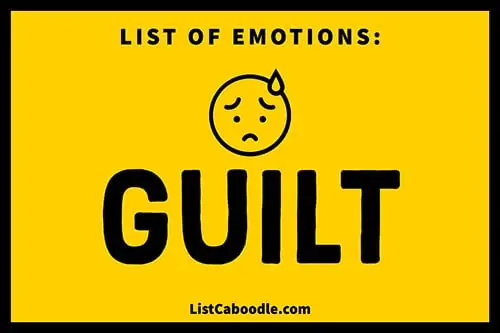
7.) Guilt
Another emotion that can cause severe distress is guilt. We normally consider it an emotion one would rightly feel after doing something wrong. We have all felt guilty about breaking a promise, hurting someone’s feelings, or doing some other kind of damage.
Usually, guilt doesn’t last long. We may apologize to the person we hurt, and they may forgive us. In this case, our guilt will likely subside.
Nevertheless, there are situations when guilt persists. Maybe because we are unable to apologize or there’s nobody to apologize to. Sometimes we do apologize, but the other person does not forgive us. In these cases, we keep feeling guilty. This can be the case when cheating on someone who will not ignore the slip. Or even worse is the case of survivor guilt, where there’s nobody to apologize to.
Guilt, when persistent or unresolved, can cause us severe emotional distress and can ruin our relationships. More often than not, we keep feeling guilty because we cannot forgive ourselves. By doing so, we carry on a self-condemnation act that does even more damage. When feeling guilty, taking steps to achieve forgiveness, from the person we hurt or from ourselves, is the first step towards better mental health.
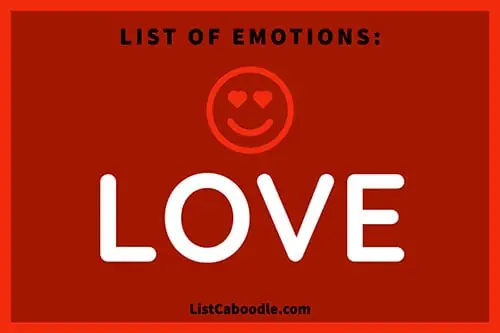
8.) Love
We couldn’t leave love out of this list of emotions. However, love does not show up on many lists of emotions. This could be due to the fact that love encompasses more emotions in one. Love is a mix of appreciation, affection, admiration, longing, passion, and desire. But love can also include negative emotions, such as obsessiveness and co-dependency.
Love can also be of many types, depending on the relationship. Therefore we will express it in different ways. We can love family members, friends, or romantic partners. Depending on the “object” of our feelings, love will include different other emotions. We can feel appreciation for both a friend and a lover, but passion is a feeling we reserve for romantic partners.
When it comes to couples, a feeling of lust, or sexual desire, is usually the first phase of the biological concept of love. Lust is followed by attraction, both of which are temporary, and by the third and last phase, attachment. From a psychological standpoint, love is made of intimacy, commitment, and passion.
Whatever the components of love, it is an emotion we all feel and need for survival. From the moment we are born, we need love to keep us alive.
Furthermore, love, and in general caring relationships, release the feel-good hormone oxytocin. This hormone helps not only to improve our mood but also to strengthen our immune system. In fact, love can make use happier and healthier.
Emotional intelligence
Understanding our emotions is the first step to achieve greater emotional health. Becoming more aware of how we feel can help us manage our emotions, especially negative ones, and avoid the damaging consequences they can have. But when it comes to emotions, it is also essential to be able to recognize them in other people. This is where emotional intelligence comes into play.
Emotional intelligence was first defined by Peter Salovey and John Mayer, two pioneers in the field. Later, David Goleman published the best-selling book Emotional Intelligence, still a point of reference in the study of EI.
The term emotional intelligence (EI) refers to the ability to recognize and understand our own emotions as well as those of others. Having high emotional intelligence means being able to manage our emotions but also to gather information about the feelings other people are feeling and use it to guide our behavior and thinking.
Emotional intelligence is a skill that we can practice. We can learn to become more aware of our emotions, to control disruptive emotions, and to pay attention to other people’s emotions. By doing so, we can improve our social skills and, therefore, our relationships.
Emotional intelligence resources
According to a 2020 World Economic Forum report, emotional intelligence is one of the top 10 skills we need to thrive in our personal and professional lives. Having high EI means having more robust and healthier relationships and being better suited to face adversity. So, practicing emotional intelligence should become a priority for all of us.
As usual, the first step in improving a skill starts with awareness. To become aware of your current emotional quotient (EQ), you can take a free online test. While not all these tests are scientifically approved, they can give you interesting insights.
There are a few reliable websites where you can find EQ tests, such as The Institute for Health and Human Potential, Mind Tools, or Global Leadership Foundation.
For further learning, the Emotional Intelligence Network is a community entirely dedicated to EI.
By Roxana Fanaru | Published 4/5/2021
Roxana Fanaru is a writer, traveler, and avid reader. She has a Master’s in Journalism. She likes writing about complicated things in a simple way.
Thank you for reading this list of emotions and feelings. You might also like: